Three Nuns & A Ballerina With The Reversible Name
Wednesday, November 01, 2006
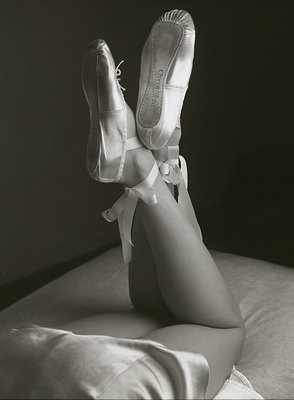 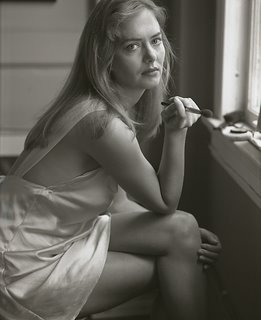 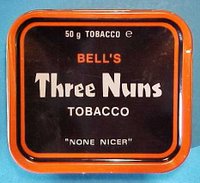 If my memory does not fail me it is that scene in Arch of Triumph (1948) where Charles Boyer and Ingrid Bergman do the cigarette thing. He lights two cigarettes and gives her one. When I saw that scene it was exquisitely romantic. In 2006 I would probably have to supress my excitement and tell you that smoking is a disgusting habit. I have kept all the pipes I ever owned in case I ever change my mind (not likely). I had as many pipes as I would smoke in a day, 5. Multiplied times 7 that makes 35. This meant that every pipe I smoked once would rest (and dry up) for a week, before I smoked it again. My favourite pipe tobacco was Bell's Three Nuns . They advertised as "None Nicer". The same feeling of romance paseé has ocurred for me when I think of high heel shoes. They look uncomfortable and they don't do anything for my receding libido. But ballerina slippers, that's another thing, altogether! I took my first ballerina slippers shot around 15 years ago. My subject was Reneé Michelle. But it easily could have been Michelle Reneé. Even 15 years ago I was confused about her name. I photographed her once in my Robson Street studio and I remember this photograph ever so fondly. It is a pity I cannot justify lighting one of my favourite Petersen (Dublin) pipes with some Three Nuns.
Mario Vargas Llosa, The Storyteller & The Gourd
Tuesday, October 31, 2006
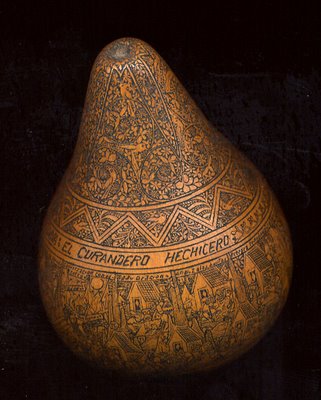 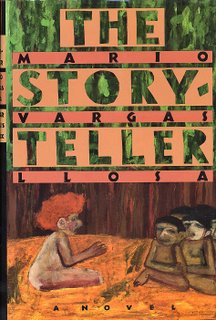 In 1989 I read Mario Vargas Llosa's whimsical The Story Teller about a long lost classmate by the narrator of the novel. Raúl Zuritas (the long lost classmate) is a red haired Jew, terribly scarred last seen in Israel. But in a small gallery in Florence, our protagonist (fleeing the political turmoil of Peru) happens on an exhibition of photographs from the Amazon jungle. One of the photographs shows a tribal storyteller seated in the middle of a circle of Machiguenga Indians. This tribe, until the late 80s, had been completely isolated from civilization. That the tribal storyteller is a dead ringer for Mascarita, is the mystery that opens this fascinatingly easy to read Llosa novel. Perhaps it was easy after having read the serpentine Conversation in the Cathedral. "Florentines are famous, in Italy, for their arrogance and for their hatred of the tourists that innundate them each summer, like an Amazonian river. At the moment, it is hard to deterimine whether this is true, since there are virtually no natives left in Firenze. They have been leaving, little by little, as the temperature rose, the evening breeze stopped blowing, the waters of the Arno dwindled to a trickle, and mosquitoes took over the city. They are veritable flying hordes that successfully resist repellents and insecticides an gorge on their victims' blood day and night, particularly in museums. Are the zanzare of Firenze the totem animals, the guardian angels of Leonardos, Cellinis, Botticellis, Fillipo Lippis, Fra Angelicos? It would seem so. Because it is while I am contemplating their statues, frescoes, and paintings that I have gotten most of the bites that have raised lumps in my arms and legs neither more nor less ugly than the ones I've gotten every time I've visited the Peruvian jungle." The Storyteller, Mario Vargas Llosa Later in 1990 I bought three intricately carved gourds ( mates berillados) in a market near Callao in Peru. The smallest is called: Historia: El Hechicero Curandero, (The Story: The Wizard Healer). The gourd brought from Chiclayo or Piura and carved in Cochas Grandes and Cochas Chico (near Huancayo) is signed by Silvia Alanya Vo. When I look at this 7cm long gourd I can imagine Mascarita weaving stories of the fabled and magical Macheguengas before men started walking. "There was no evil, there was no wind, there was no rain."
Don Harron, Katherine Hepburn & Old Prune
Monday, October 30, 2006
 Just a few days ago I saw a wonderful interview of Katherine Hepburn by Dick Cavett that originally was aired on September 14, 1973. It made me think of my photo date with Don Harron about 6 years later. Les Wiseman and I had an appointment with him at a hotel on Denman Street. As we entered the hotel I noticed Mr. Harron coming out of the elevator and going out. I stopped him and pointed out that we had an interview. He was anoyed and said that it was impossible. He looked at Les and I and said, "I was a journalist once. Let's go upstairs and I will grant you a quick interview." In his room, during the interview he explained to Wiseman how he had once been "discovered" backstage by Katherine Hepburn. He then went into a luxury of detail to explain how Ms Hepburn's skin resembled a dried old prune. When it was my turn to photograph him he said, "Guess who is going to photograph me tomorrow? " Without giving me time to guess he said, "Karsh of Ottawa." I removed a deep green filter from my camera bag and screwed it on to the front of my lens. Harron, asked, "What's that for? " "To make your skin resemble Katherine Hepburn, " I told him. In my 32 years in Vancouver this may have been the first and last time that I ever made anybody look worse than they looked.
One Screen Siren Less
Sunday, October 29, 2006
 One of the advantages of being a photographer is that sometimes you can get away with the cliche, "I am a photographer and I think you are beautiful. I would like to photograph you." My percentage of success is in the high 90s! I was lucky to photograph B.H. once and here is one of my favourite pictures of her. I don't remember why I asked her to look sad at my camera. But the photograph captures how I now feel seeing that she is gone back east. Of her change B. " It's a bittersweet change--I'm going to miss you all and this city that is my home--but I know I'll be back in the not-too distant future." It is my hope that she returns soon as I would like to re-photograph her, this time I would ask her to wear a smile.
To The Ends Of The Earth & Crossing The Equator
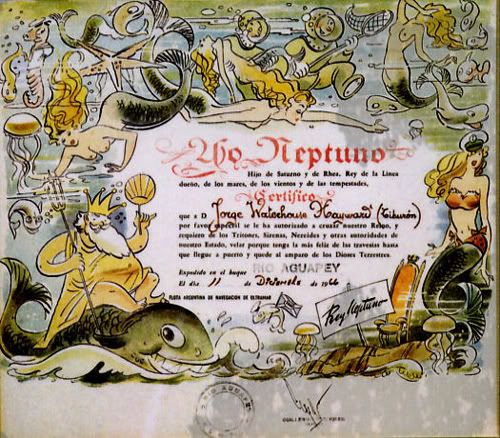 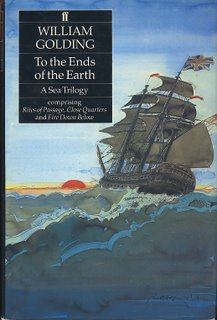 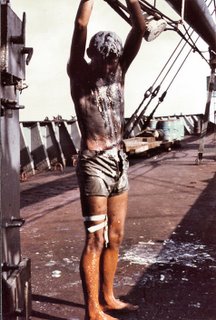 I am a sucker for seafaring yarns and I have read all of Patrick O'Brian's Aubrey/Maturin novels twice plus Golden Ocean and The Unknown Shore. I have read several Nelson biographies and Frederick Marryat's Mr. Midshipman Easy. I was hooked as a teenager when my mother lent me Admiral Hornblower in the West Indies in 1957. After that I found and read all of the series by C.S. Forrester. So when I "discovered" William Golding's sea trilogy To the Ends of the Earth a couple of years ago I bought it but somehow I postponed reading it. This thick book includes Rites of Passage, Close Quarters and Fire Down Below. Then I read the preview to last Sunday's British TV production version of To the Ends of the Earth on PBS. It features a great cast but Rosemary and I were mesmerized by Jarred Harris's performance as Captain Anderson. Harris is the son of Richard Harris. In last week's first episode remarkable things happen belowships during the hazing of a parson during the crossing of the equator. The production is quite faithful to the book (I am now ready for the second installment tonight) but the crossing of the equator is but a vague diversion in the novel. Seeing the terrible hazing of the parson I remembered that I, too, suffered, but a much reduced version that included Prussian Blue oil paint, adhesive tape on my legs and being sprayed with a sea hose while chained to a boom. It happened on board the Empresa Lineas Maritimas Argentinas (ELMA) Victory ship, Rio Aguapey, on December 11, 1966 off the coast of Brazil. Captain Guillermo Migliorini signed my certificate which made me a full fledged tiburón or shark. Another incident in To the Ends of the Earth is crucial to the story. Our young hero, the upper class gentleman Edmund Talbot steps up to the quarterdeck and Captain Anderson is not able to vent his anger( the young man might have influencial patrons) at this break of naval tradition that only those who are invited can do so. When the hapless parson does so, since he is not a gentleman, Anderson boots him off the deck. I remember on my second day on the Rio Aguapey (we shoved off from Buenos Aires on our way to the ports of Brazil, Puerto Rico, New Orleans, Houston and Veracruz) that since I was the only passenger on board I thought I would have special privileges. I went up to the bridge uninvited. I quickly found out that while the Argentine Merchant Marine ship, the Aguapey was not a British ship of the line, the same holy traditions prevailed. Captain Migliorini stared at me impassively while the second officer grabbed me and took me down quickly explaining my terrible faux pa.
Budstock, Nancy G, Zippy Pinhead, Art & Bud Luxford
Saturday, October 28, 2006
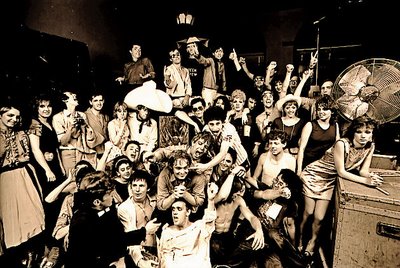
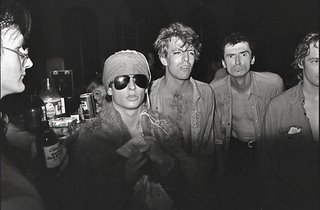
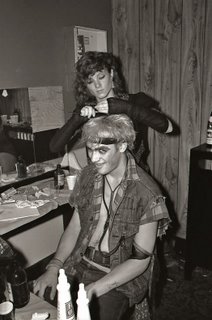
Sometime soon after August 31st 1982, I went to an "alternative scene" rock band concert at the UBC Sub Ballroom. A couple of guys in front of me where whispering. In spite of the loud band, I was able to hear what they were saying. "These guys look like they all went to the same hair stylist," said one of them. The other guy countered, "They do." He was right. Anybody who was anybody in the alternative scene (those bands that you could not listen to on commercial AM or FM radio except in UBC's CITR Radio) went to Nancy Gillespie (we all called her Nancy G). Why do I know this happened right after August 31st 1982? I remember telling my wife Rosemary, "I am going to get my hair cut by Nancy G. I am getting one of her asymmetrical cuts." I want to do something different to celebrate my birthday. Rosemary cautiously(she made me feel so old!) said, "Be careful, remember you are going to be 40."
On July 30, 1981 I attended Bud Luxford's record release party held at the Commodore Ballroom. It was called Budstock and he advertised it as: $5 for 10 bands (That's 50c per band not counting calories). Anybody who was important in the alternative scene played that night in what were called "Fu--Bands". These were bands made up from members of well known bands who switched instruments or in some cases drummers became singers, etc.
I had given myself one mission that night. I was going to take a group shot of all the participants and organizers. Here it is. Smack in the middle you have Bud Luxford. To his left that's Art Bergmann. At the bottom, centre it's Pointed Sticks's lead singer Nick Jones. On the extreme right that's Nancy G. In one of the few other shots I took that night you can see a very drunk Art Bergmann. In the third shot Nancy G is working on Zippy Pinhead, back stage. You can notice in this picture Nancy G's strange but beautiful eyes. We all had the hots for Nancy.
Many women in Vancouver had the hots for Zippy. In a Western Music Awards night I was standing with Zippy. His hands were filthy. A woman came up to him and asked, "Why are your fingernails so dirty?" Zippy explained, "I work in a garage and I put my hands in car grease. What do you expect?" The immaculately dressed woman then said, "What's your phone number?"
Kathleen In Red and Blue
Friday, October 27, 2006
I have never really thrown any of my old pictures away. The ones that do get lost are usually the valuable ones that are valuable, only, in that the subject of the picture is not around or dead. Kathleen is alive and well. The last time I located her she was working as a most efficient accountant for Sam Feldman and Associates on Granville Island. When I photographed her many years ago in my Burnaby basement garage studio I was fascinated by red hair. I am still fascinated by the complexity of rendering a realistic skin colour which eludes most film cameras when faced with redheads.
At the time I thought I could colour print from colour negatives. I wasn't too bad except with red heads. To make it worse I decided I was going to photograph Kathleen with a "blue" rose. I left the white rose soaking in Parker Pen royal blue ink for a day. This is as blue as it ever got. But I am happy with the look of the b+w portait. Kathleen had and has a face that could launch ships.
With A Rose - Reprised
 If that previous picture of Kathleen with a rose failed, it failed not because of Kathleen, but because I have since found out that photographs of people, and women in particular, with roses, cherries, strawberries, etc displayed on their faces or in other parts of their anatomy are most often doomed to failure. There have been a few, for me, recent exceptions. This photograph of dancer Sandrine Cassini with Rosa 'L. D. Braithwaite'is one of my favourite atttempts.
Thursday, October 26, 2006
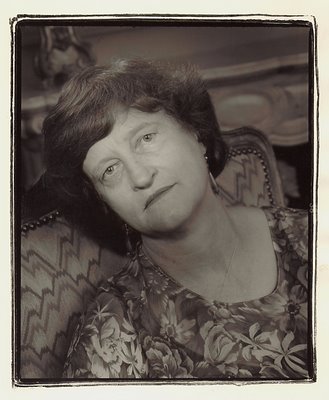
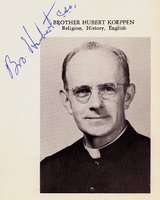
A nice foil to a good mystery is a book of essays. In recent years, Henry Petroski has expounded on ferris wheels ( Remaking the World - Adventures in Engineering), Stephen Jay Gould has shown how natural selection has prevented anybody from batting 400 over a season since Ted Williams in 1941 ( Full House)and I have learned all about the Swiss Army in John McFee's La Place de la Concorde Suisse.
For essays on food (and chewing gum), nobody tops South African-born Toronto/Barcelona/South of France resident Margaret Visser. In her 1994 book The Way We Are, I found out why Pythagoras commanded his vegetarian followers, "Abstain from beans!" And in September of that year I had the good fortune of taking Visser's photograph in her room at the Hotel Vancouver.
We discussed her mention in her book of the first sunbathing scene in French Literature. In 1902, the hero of André Gide's book L'Immoraliste took off his clothes and lay down in the sun.
This made me remember the first recorded incident in history of someone taking a sun bath. I had learned of this from my wonderful teacher, Brother Hubert Koeppen at St Edward's High School in Austin, Texas. Brother Hubert had instilled a love of history in me that had all started with such facts.
I asked Visser if she knew of that mention in ancient history involving Alexander the Great and Pindar the Poet in Thebes. Visser answered, "You have it wrong - It was Alexander and Diogenes the Cynic in Corinth." We made a $10 bet.
She wrote her address in my copy of The Way We Were and it was an address on Euclid Street in Toronto. I also noticed that the book's dedication was in classic Greek. I knew I was in trouble.
A few weeks later, a neat handwritten letter arrived from Euclid Street. Included was a copy of a page from Plutarch's Lives in both English and Greek. It read,
"....a vote was passed to make an expedition against Persia with Alexander, and he was proclaimed their leader. Thereupon many statesmen and philosophers came to him with congratulations, and he expected Diogenes of Sinope also, who was tarrying in Corinth, would do likewise. But since the philosopher took not the slightest notice of Alexander, and continued to enjoy his leisure in the suburb of Craneion, Alexander went to see him; and found him lying in the sun. And when that monarch addressed him with greetings, and asked him if he wanted anything, 'Yes, 'said Diogenes, stand a little out of my sun.'" I sent Visser a cheque for $10.
I am about to re-read one of my favourite books. This is Visser's The Geometry of Love - Space, Time, Mystery, and Meaning in and Ordinary Church. This beautiful book about Sant'Agnese fuori le mura in Rome is a biography of a church that is not all that ordinary. One of the floors in the canonry of the 1,350-year-old building collapsed on April 12, 1855 and 105 people, including Pope Pius IV, fell through to the floor below. No one was injured.
For me entering a synagogue, a mosque, a Buddhist temple or my neighbourhood church will never be the same after having read this book. But Visser was up to her old tricks (Brother Hubert would have approved) in gently teaching us Greek and Latin and how they have put an indelible stamp in our language Would you ever guess that it was the virtuous St Peter who was the source of the word scandal?
Simon, son of Jonah, himself nicknamed Peter, "the stone, "was later to comment on the relationship between the crucifixion of Jesus (his "rejection") and his status now as "the corner stone" of the new view of the world. People who do not believe that Jesus is the Christ foretold will not think him a "cornersone" at all, Peter wrote; they will find him a "stumbling-block." The latter expression in Greek is petra skandalou , the origin of the English "scandal"; it means a stone that people fall over. Page 83, The Geometry of Love.
Margaret Visser
|
























